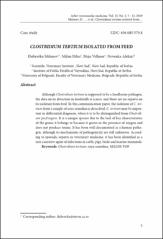| dc.contributor.author | Milanov, Dubravka | |
| dc.contributor.author | Đilas, Milan | |
| dc.contributor.author | Velhner, Maja | |
| dc.contributor.author | Aleksić, Nevenka | |
| dc.date.accessioned | 2020-03-01T19:24:20Z | |
| dc.date.available | 2020-03-01T19:24:20Z | |
| dc.date.issued | 2019 | |
| dc.identifier.issn | 1820-9955 | |
| dc.identifier.uri | https://repo.niv.ns.ac.rs/xmlui/handle/123456789/266 | |
| dc.description.abstract | Although Clostridium tertium is supposed to be a foodborne pathogen,
the data on its detection in foodstuff s is scarce, and there are no reports on
its isolation from feed. In this communication paper, the isolation of C. tertium
from a sample of soya semolina is described. C. tertium may be important
in diff erential diagnosis, when it is to be distinguished from Clostridium
perfringens. It is a unique species due to the lack of key characteristics
of the genus it belongs to because it grows in the presence of oxygen and
does not produce toxins. It has been well-documented as a human pathogen,
although its mechanisms of pathogenicity are still unknown. According
to sporadic reports in veterinary medicine, it has been identifi ed as a
rare causative agent of infections in cattle, pigs, birds and marine mammals. | en_US |
| dc.description.sponsorship | Th e authors are thankful for support granted by the Ministry of education,
science and technological development of the Republic of Serbia for Scientifi c
Projects No. TR 31071 and III 46002. | en_US |
| dc.language.iso | en | en_US |
| dc.publisher | Naučni institut za veterinarstvo "Novi Sad" | en_US |
| dc.source | Arhiv veterinarske medicine / Archives of veterinary medicine | sr |
| dc.subject | Clostridium tertium | en_US |
| dc.subject | soya semolina | en_US |
| dc.subject | MALDI-TOF | en_US |
| dc.title | Clostridium tertium isolated from feed | en_US |
| dc.title.alternative | Izolacija Clostridium tertium iz hrane za životinje | en_US |
| dc.type | Article | en_US |
| dc.identifier.doi | 10.46784/e-avm.v12i2.58 | |

